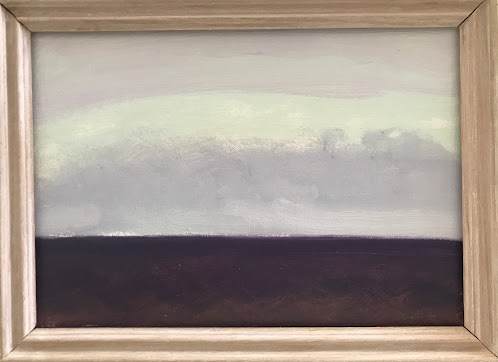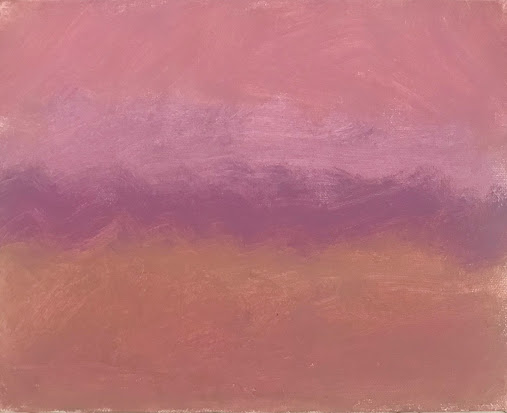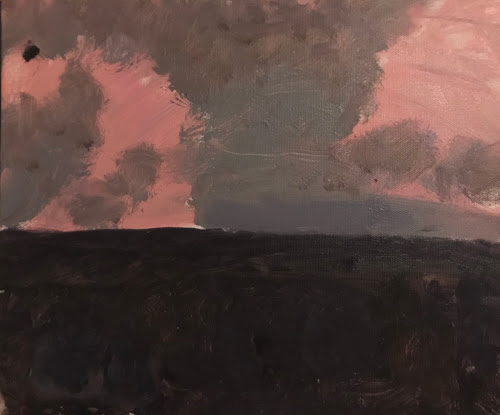Untitled, Dieulefit, 2005?, oil on plywood, 100 X 100 cm
I was thinking this morning about all the craziness which seems to rule our minds these days, and it occurred to me that among many things that might relieve this fact of modern life, even just temporarily, are paintings. But naturally, I would say this, not just because I am a painter but because I believe in the power of paintings to undo many of the knots in our souls (temporarily,,,, maybe,,, but at least for a moment). And aren't moments by moments how we experience life? Like they say, Time was invented, but life is lived from moment to moment, breath to breath, like watching a cloud change shapes.
But for those lucky people who have a few paintings on their walls which they really adore and look at even for a few moments during the day, why it can shift the mind and be balm for the soul.
The problem with this is that for most people these days, paintings are near the bottom of their priority list. It's just the way it is these days. There are too many other balms for our should out there.
Yet poetry can do this too because for someone who loves poetry, even just a small reading can shift one's thinking if only for a short space of time.
I guess what I am saying is that it is Art that can bring relief from all sorts of madness both inside and out of us. Longer relief than a latte or MacDonalds burger.
I live by this idea but I do understand that most others do not. I make pictures for myself first and foremost, asking "Are they any good?" and after a while, "How do they make me feel?" I ask always, "Are they anecdotes or antidotes to this present moment?".
Whenever I lived in a city, any city but mostly NY, and whenever I had the BLUES (which was a lot) I would fly up to the Met by subway as fast as I could. Normally I enjoy spending many moments in museums anyway, but when I felt that PANIC rise inside I always knew where find to relief. But I confess that I would also usually grab a fat cheesy New York pizza slice (or two) from the small shop on 79th street at the top of the entrance to the subway. (Hey we gotta do everything we can when we cannot seem to shake the Blues).
But it really took me a long time before I was able 'to paint my panic away'. It took a very long time because most of my panic, in fact, arose from the fact that I was indeed panicked because I couldn't paint! A real conundrum.
What got me out of this was when I began these non-objective pictures which housed barely any context at all. Though they were not entirely without an idea of the slimmest sort, they were really about the paint, squirting it, mixing it, diluting it, brushing it on any surface and just feeling the thick paint as the brush mopped it around the palette.
And I have also always believed in the emotional drive of a painting, how it speaks to a viewer, what it says and how it says it. I mean, if a viewer's sensibility cannot be soothed or squeezed, charged and lit up like a light bulb, what's the point?
I know the Art world is now a large tent (as it should be) but the Painting World, slightly more narrowly refined, in a certain way (and as it also should be), occupies a far smaller space in that tent. And yet somehow the quality of the paint itself sets it miles apart from all the other weirdos on the block (in the tent I mean). For Art should always be for, and about weirdos, for the sensitive and very curious among us, no matter how poor is our dress code, or how crazy or inane our tics truly are, if a painter is original, then all will be good, or at the very least OK.
But I want to exclaim, to shout out to the bustling people in the office buildings above me; Painting is a sensual affair! It may not be too fashionable in this photo-world-of-realism but for me, it's in my DNA, I cannot help but to feel this. Fortunately, I know other weirdos like me (and there are many of us skulking about). Painting is a visceral (and visual) experience not a contextual message. It's an act of the holy kind, it's enough to heal a painter's anxiety just by mixing a palette of thick paints. It might be enough to heal the insanity of a viewer just long enough to keep him or her from jumping onto a subway track.
And like a cook, when unduly anxious or full of panic, enters into a kitchen to make a dish it's an act of faith, for the cook knows that stress will melt like butter after slicing and dicing and mixing and mashing one's own meal. Francis Ford Coppola was known to make pasta sauce from scratch in his trailer on the film set where he retreated when he was really stressed during a film shoot.
And like the cook, the risk of failure for a painter is also great, for paint like food, once mixed cannot be returned to its original state, so when a painter fails, it ends up in the trash but in the cook's case, it's thrown out the window for the chickens.
And what about writers! I won't even start! They are a notoriously unhappy lot, and big drinkers too. They find solace in books and bars apparently.
But in paint, the redemptive magnificence is totally real for the painter. For civilians there is always a trip to the museum.











































